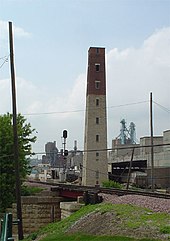Shot tower


Ashot toweris atowerdesigned for the production of small-diametershot ballsbyfree fallof moltenlead,which is then caught in a water basin. The shot is primarily used forprojectilesinshotguns,and forballast,radiation shielding,and other applications for which small lead balls are useful.
Shot making
[edit]Process
[edit]In a shot tower,leadis heated until molten, then dropped through acoppersievehigh in the tower. The liquid lead forms tinysphericalballs bysurface tension,and solidifies as it falls. The partially cooled balls are caught at the floor of the tower in awater-filled basin.[1]The now fully cooled balls are checked for roundness and sorted by size; those that are "out of round" are remelted. A slightly inclined table is used for checking roundness.[2]To make larger shot sizes, a copper sieve with larger holes is used.
The maximum size is limited by the height of the tower, because larger shot sizes must fall farther to solidify. A shot tower with a 40-meter drop can produce up to #6 shot (nominally 2.4mm in diameter) while an 80-meter drop can produce #2 shot (nominally 3.8mm in diameter).[3]Polishingwith a small amount ofgraphiteis necessary forlubricationand to preventoxidation.

History
[edit]The process was invented by William Watts ofBristol,England, and patented in 1782.[1][4]The same year, Watts extended his house inRedcliffeto buildthe first shot tower.[5]Use of shot towers replaced earlier techniques of casting shot in moulds, which was expensive, or of dripping molten lead into water barrels, which produced insufficiently spherical balls. Large shot which could not be made by the shot tower was made by tumbling pieces of cut lead sheet in a barrel until round.[6]
The "wind tower" method, which used a blast of cold air to dramatically shorten the drop necessary and was patented in 1848 by the T.O LeRoy Company of New York City,[7][8]meant that tall shot towers became unnecessary, but many were still constructed into the late 1880s, and two surviving examples date from 1916 and 1969. Since the 1960s theBliemeister methodhas been used to make smaller shot sizes, and larger sizes are made by the coldswagingprocess of feeding calibrated lengths of wire into hemisphericaldiesand stamping them into spheres.[9]
Examples
[edit]Gallery
[edit]-
Philadelphia, USA
-
Hobart, Tasmania
-
Melbourne, Australia
-
Bristol, England
-
Melbourne, Australia
-
Dubuque, USA
-
Colonial Ammunition Company,Auckland, New Zealand
-
Virginia, USA
-
Katowice, Poland
-
Bojárd, Hungary (1936-1938)
-
Tata, Hungary (1939)
See also
[edit]- Drop tube,a similar concept, but used for scientific experiments
- Prill,a small granule of material formed by a similar process to shot-making. Often used in the chemical industry for solid chemicals.
- Spray dryingis a process of turning liquids into powder; many spray dryers also have the drops of liquid solidifying as they drop in a tower.
Further reading
[edit]- "Up a shot tower".The Strand Magazine.1891. p. 205.
References
[edit]- ^ab"No. 422: Shot Tower",Engines,UH.
- ^Re: How the small lead shot (7–8 sizes) used for shotgun shells are made?,Mad sci, May 2001.
- ^Lipscombe, Trevor C.; Mungan, Carl E. (2012),"The Physics of Shot Towers"(PDF),The Physics Teacher,50(4): 218,Bibcode:2012PhTea..50..218L,doi:10.1119/1.3694072
- ^Minchinton, Walter (1993)."The Shot Tower"(PDF).The Shot Peener.7(3): 22.
- ^"Sheldon Bush and Patent Shot Company Limited, Cheese Lane, Bristol",Images of England.
- ^"150th",The Age,Melbourne,AU,archived fromthe originalon February 12, 2006.
- ^"Shot_Towers".Archived fromthe originalon January 30, 2012.RetrievedSeptember 12,2013.,Lynne Belluscio, LeRoy Penny Saver News
- ^History of the American Shot TowerArchivedAugust 11, 2005, at theWayback Machine
- ^"The romance of lead shot".Shotgunner – Guns Magazine.Archived fromthe originalon May 5, 2006 – via findarticles.com.
External links
[edit]- "Gravity Molds Shot In A Modern Tower", October 1944, Popular Sciencedetailed and large article on subject of Shot Towers











